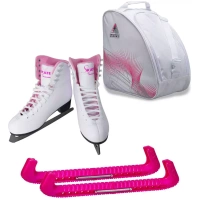Whether you are a beginner ice skater or know your way around the skating rink, you should know the importance of correct ice skate lacing. The correct way of lacing is essential to lock the foot in its natural position inside the boot. It allows the boot to work in the most efficient way and guarantees the best performance. It prevents your skating boots from premature wear-out, thus extending their life. And let us not forget about the essential support of your ankles, which prevents your feet from unfortunate injuries and getting tired too soon.
What is the correct way of tying ice skates?
Whether you are a beginner ice skater or know your way around the skating rink, you should know the importance of correct ice skate lacing. The correct way of lacing is essential to lock the foot in its natural position inside the boot. It allows the boot to work in the most efficient way and guarantees the best performance. It prevents your skating boots from premature wear-out, thus extending their life. And let us not forget about the essential support of your ankles, which prevents your feet from unfortunate injuries and getting tired too soon.
The direction of shoelace when it goes through the eyelets.
The correct direction of shoelaces should be from exterior to interior. This means that you insert the lace from outside to the inside of the boot, up to down. It lessens the pressure on the foot instep, fastens the boot and makes the lace self-blocking.
The correct way of lacing to stabilize the tongue.
Our feet are not symmetric. Anatomically, the inside edge is higher and has more volume than the outside edge. With each stroke the skater makes, the tongue shifts to align with the anatomical shape of the foot, i.e., towards outsides. The tongue’s function is to protect the foot instep and help with leg flexion. Therefore, correct lacing is essential to prevent shifting and stabilize the leg.
In some boots, there is a textile loop sewn in the joining area of the tongue. Run one lace through the loop and twist it, or run both laces through the loop and out in different directions. If your ice skates model does not have that textile loop, you can punch two holes on the tongue and follow the same procedure.
The correct way of lacing around the upper hooks.
Follow a crisscross pattern in the center and lace around the hooks. Circle the laces around the hooks from the top to improve the hook’s function, lace self-blocking and feature a lace V-shape to help flexion.
The correct lace tension in different areas of the boot.
Incorrect lacing tension means that it is too tight in the hook area, too loose in the instep and tight in the front (tight – soft – tight). It not only makes the boot deform but also the hockey or figure skater’s ankle not safely secured. The correct lacing tension follows the ‘egg pattern’. The lacing is rather loose in the top area, firm around the hooks and tight in the instep area, and loose in the toe area (soft – tight – soft). This way, you will get the flexibility to bend your knees comfortably, your ankles are secured, and the boot is easier to maneuver.
A step-by-step guide to lacing figure or hockey skates.



Some tips that will improve your ice skate lacing.
- Unlace the boot all the way down. This way, you will release the tension at the boot and prolong its perfect fit. Do not leave boots laced in a hot place, as they could deform.
- Do not wear heavy socks. They will disturb the fit of the skate and distort the feeling of the boot. Go with a pair of trouser sock or knee-highs. Avoid cotton socks, because they will absorb all the moisture from your feet and become uncomfortable.
- Keep your ice skates dry. After taking them off, wipe the blade and underside of the boot to dry them out. To avoid the rust, store them with dry soakers on the blades.
- If after the lace-up you feel that the skates are too loose, you should redo the lacing. Do not get lazy, as unstable ankles are a direct way to injury.
- Figure skates should not be too tight. If you have difficulty bending knees, go back and re-tie them.
- Make sure the skate tongue is straight and does not slip under the laces.
- Skates must fit properly. If the boot is too big, tight lacing will not improve the skating experience. Learn how to measure your feet and find the right size of ice skates here.





